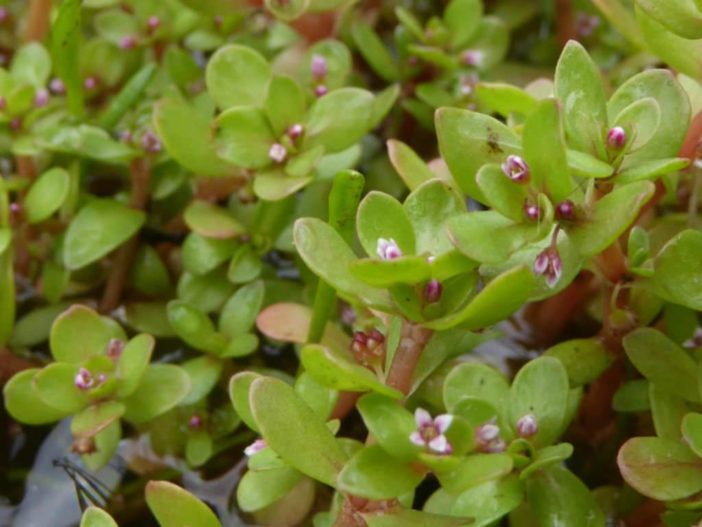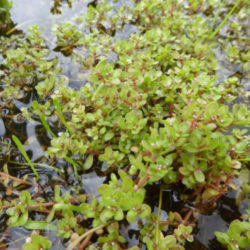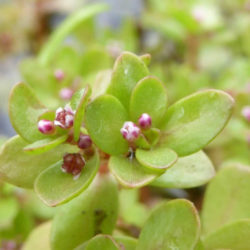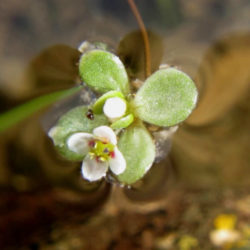Scientific Name
Crassula natans Thunb.
Common Names
Floating Crassula, Floating Pigmyweed
Synonym(s)
Bulliarda capensis, Helophytum natans, Tillaea filiformis, Tillaea filiformis var. parvula, Tillaea fluitans var. intermedia, Tillaea fluitans var. obovata, Tillaea reflexa
Scientific Classification
Family: Crassulaceae
Subfamily: Crassuloideae
Genus: Crassula
Description
Crassula natans is a usually aquatic annual or rarely rhizomatous decumbent perennial with branches that can be erect, decumbent, or floating in the water. The branches are slender and up to 14 inches (35 cm) long. The branches are often multi-branched when growing in a marshy area. Leaves are green, oblanceolate to obovate, up to 0.3 inches (0.8 cm) long in marsh plants or up to 0.6 inches (1.5 cm) long in floating plants.
Flowers are cup-shaped, white or pinkish, and appear mostly near branch tips from summer to fall.
Origin
Crassula natans is native to South Africa and Lesotho.

Hardiness
It is grown as an annual plant, so it has no USDA hardiness zone.
How to Grow and Care
This Crassula is endemic to the wetlands of the Cape Fold area of the Western Cape region of South Africa. It has become naturalized in Western Australia, where it grows in wet winter depressions and gullies and lakes in the Great Southern, Wheatbelt, South West, and Peel regions. It is also found throughout southern South Australia, New South Wales, and Victoria.
It grows in moist soil, often in clay pans and in and around shallow standing water of dams and rock pools. On moist soil, plants are often deep red, tufted, less than 2.4 inches (6 cm) tall, and with up to 3 flowers per node. When inundated, the floating branches become up to 14 inches (35 cm) long and are swollen at the base where they bear linear leaves, while the floating leaves are oblanceolate and much broader and rarely produce more than one flower per node. The floating stems are little-branched and may be unbranched in plants growing in rock pools without much organic matter.
Collect whole plants drying off, turning red-brown with mature fruit spikes. These will contain tiny brown seeds when rubbed with your fingers. Place the plants in a tray and leave them to dry for two weeks. Then rub the plants gently by hand or with a rubber bung to dislodge the seeds. Use a sieve to separate the unwanted material. Be very careful, as the seeds are tiny. Store the seeds with a desiccant, such as dried silica beads or dry rice, in an air-tight container in a cool and dry place.
Varieties
Links
- Back to genus Crassula
- Succupedia: Browse succulents by Scientific Name, Common Name, Genus, Family, USDA Hardiness Zone, Origin, or cacti by Genus
Photo Gallery
Click on a photo to see a larger version.


